December 25, 1909 - April 21, 1996
Biography
- Born: "Zachary Arkuss" on December 25, 1909 to Russian parents near Brussels, Belgium. During his teens, Zora's parents divorced and his mother later remarried, hence the name "Arkus-Duntov".
- During his early years in Berlin, Germany, Zora worked at a motorcycle shop and soon after, started racing motorcycles. Due to the danger of motorcyle racing and his parents' request, he stopped motorcycle racing and turned his attention towards cars.
- In December of 1934, Zora graduated with a degree in Mechanical Engineering from the Institute of Charlottenburg in Berlin where he specialized in engine development and supercharging. Due to a paper he wrote on supercharging and his many affiliations with auto racing teams, he won a consulting contract with the Mercedes Grand Prix racing team.
- In 1938, Zora wrote another paper, this time on the benefits of four-wheel drive and steering for high performance vehicles. This particular paper was published by the German Auto Club magazine.
- In 1939, Zora married Elfi Wolff, a 17 year old, German native and dancer in the Folies-Bergere in Paris. It was also at this time that Zora joined the French Air Force and served in the military through 1940.
- Zora eventually moved to the United States with his brother "Yuri" and started a successful manufacturing company called, "Ardun Power Products" where they manufactured aluminum overhead valve heads for the flathead Ford engine. These special aluminum heads enabled the engine to produce 300+ horsepower. Several cars equipped with these heads went on to set records and helped to establish Zora's engineering capabilities in the U.S.
- In early 1950, Zora moved to England and helped Sydney Allard with his racing operation and drove the Allard J2 in LeMans in 1952 and 1953. It was also at this time that he worked for Daimler-Benz and Porsche as a consultant. In 1952, Zora came back to the United States and joined Fairchild Aviation. Shortly after his arriaval at F.A., he spotted the Corvette at the GM Motorama Show which was held at the Waldorf-Astoria Hotel in New York.
- After seeing the 1953 Corvette for the first time, Zora wrote a letter to Chevrolet Chief Engineer, Ed Cole outlining his ideas for improving the Corvette. Ed Cole and another engineer, Maurice Olley, were so impressed with Zora's letter that they invited him to meet with them in Detroit. He was hired on May 1, 1953 as an assistant staff engineer. On December 16, 1953, he outlined a letter entitled: "Thoughts Pertaining to Youth, Hot Rodders and Chevrolet". In this letter, Duntov outlined the importance of the V8 engine and the importance of promoting the Chevrolet nameplate to the youth of America. (View this Memo)
- Even though the Corvette's styling was popular, the engineering that went into the car was lacking. The Blue Flame 6-cylinder engine and automatic transmission did not provide the performance that owners and sports-car enthusiasts expected. As a result, sales gradually fell off and the fate of the Corvette was far from promising. There were however, several people within Chevrolet that wanted to see the Corvette succeed and Zora led the way as seen in his now famous memo written to Ed Cole and Maurice Olley on October 15, 1954. (View this Memo) Zora's memo outlined what he saw wrong with Corvette and Chevrolet's marketing and the changes he felt necessary to turn the Corvette around and shape it into the world-class sports car it was meant to be. As a result, Chevrolet management agreed, Zora worked his magic, and Corvette sales escalated.
Accomplishments
- The 1956 Corvette received a 210-hp, 265 ci V8, a 225-hp, dual 4-barrel 265ci engine and a special 265ci engine sporting the infamous "Duntov Cam" resulting in 240-hp. The 1957 Corvette received the 283 ci V8 and fuel injection. This marked the first year that fuel injection was available on a Corvette. The idea of fuel injection was Zora's and Zora was responsible for encouraging Chevrolet management to undertake this costly joint venture with Rochester Products, however, the system was ultimately designed and built by John Dolza, another engineer. The 283 ci engine combined with fuel injection now had an output of 283 hp. The Corvette won the honors of being the first production-based passenger vehicle in the world to sport one horsepower per cubic inch.
- Zora started to build the Corvette SS (Project XP-64) around the end of 1957. After the SS came the Chevrolet Engineering Research Vehicles (CERV) I and II, the legendary Grand Sport Corvettes which gave Carroll Shelby's Cobra's a run for their money, the XP-880, XP-882 and many others. Along with all of these special one-off creations, Zora continued to push the Corvette's envelope of performance by releasing various racing packages as Regular Production Options (RPOs) for the Corvette.
- The legendary 1963 Z06 Corvette was born. This special performance equipment package consisted of a 327 ci, 360 hp fuel injected V8 with 4 speed manual transmission, positraction rear-end, 36-gallon fuel tank, heavy duty shocks, springs, power brakes with finned drums and much more. Zora incessantly worked at convincing Chevrolet that in order to keep the Corvette competitive in racing, greater performance was necessary. This opened the door to bigger brakes and more powerful engines. The 1967-1969 L88 Corvettes, the ZL-1, 1970-1972 ZR-1 and ZR-2 were his eventual offspring.
- As the early 1970's drew near, so too did big government and insurance companies. Leaded gas became a thing of the past as well as increased government safety restrictions. Along came the insurance companies which drastically increased premiums on high performance automobiles such as the Corvette. In an attempt to keep the Corvette at the forefront of performance, Zora continued to increase the size of the Corvette's top engine option to 454 ci, but this too became a thing of the past and the days of the roaring legendary 427 big block were long gone. It was during this time that Zora kept working on what he considered to be the ultimate Corvette; a special four wheel drive, mid-engined Corvette known as the XP-882 which later became the four-rotor XP-895. However these plans were not well received by Chevrolet corporate management and were quickly squashed. Zora retired from Chevrolet in 1975.
- Although Zora retired from his position in 1975, he remained as a consultant to Chevrolet as well as many other companies such as American Custom Industries and Holley. It was his work with ACI which ultimately led to the limited edition, "Duntov Turbo" Corvette. This customized convertible came equipped with a turbocharged 350 ci V8 and upgraded suspension. Unfortunately, like the early 1970's Corvettes, Zora became dissapointed in the poor performance and sales figures of the car.
- Gradually, Zora began to reduce his consulting jobs and enjoy his many hobbies, one of which was flying. He owned a small plane and enjoyed taking short trips from time to time. He also began making more and more appearances at major Corvette events around the country along with his wife, Elfi Duntov. It was not uncommon to see Zora and Elfi spending hours signing autographs and chatting with the long lines of admiring Corvette owners and enthusiasts who would patiently wait to see and talk to the man who was responsible for fostering their love affair with the Corvette.
- On Sunday, April 21, 1996, Zora Arkus-Duntov, quietly passed away at St. John's Hospital in Grosse Pointe, MI at the age of 86 due to cancer-induced kidney failure.
Below is the obituary that appeared in The Detroit News on April 23, 1996:
Zora Arkus-Duntov, father of the Corvette, dies
By Wes Raynal / The Detroit News
Zora Arkus-Duntov was called the "Father of the Covette," a dream maker, and a Detroit legend. Duntov died Sunday of natural causes at St. John Hospital in Detroit.
He was 86
Duntov began his 22 years at Chevrolet in 1953. he was first drawn to the division after seeing the XP-122 Corvette prototype at a General Motors Corp. auto show.
Duntov wrote to Ed Cole, then Chevrolet's chief designer, appraising the XP-122. Cole was said to be impressed enough by Duntov's letter that he asked him to join Chevrolet as a research and development engineer.
Duntov did in 1956. He was named the Corvette's engineering coordinator just a year later, and was also named director of high performance vehicles.
In 1968, Duntov became chief engineer on the Corvette.
He was responsible for such advances as disc brakes, independent rear suspension and limited-slip differentials, all of which were found on production Corvettes.
Outside of engineering circles, Duntov drove in major automobile races, winning his class at Le Mans in 1954 and 1955, and setting the Stock Car class record at the 1956 Pikes Peak Hillclimb.
Dunov, born to Russian parents in Belgium, came to America in 1941. He had graduated from the Institute of Charlottenburg in Berlin in 1934 with a degree in mechanical engineering.
Duntov served as a consultant to Chevrolet after retiring in 1975.
Visitation is from 2-9 p.m. Wednesday at the A.H. Peters funeral home, 20705 Mack Av., Grosse Point Woods.
Copyright 1996, The Detroit News
References: "Duntov, The Man Behind The Corvette" - from the Editors of VETTE magazine, 1996 |

"The Corvette was no dog anymore."
- Zora speaking about the the Corvette after setting a 150 mph top-speed record at Daytona, December, 1955.
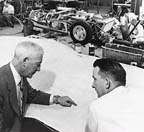
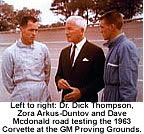



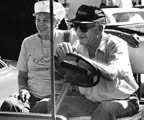
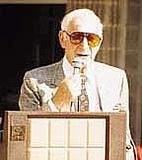

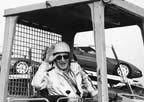
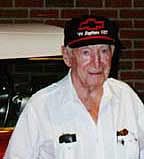
|
